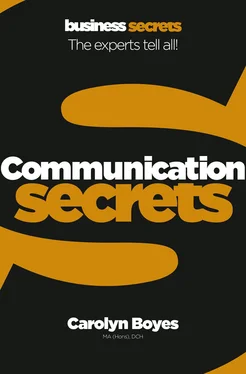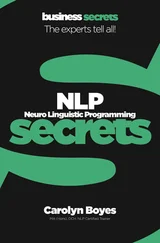Carolyn Boyes - Communication
Здесь есть возможность читать онлайн «Carolyn Boyes - Communication» — ознакомительный отрывок электронной книги совершенно бесплатно, а после прочтения отрывка купить полную версию. В некоторых случаях можно слушать аудио, скачать через торрент в формате fb2 и присутствует краткое содержание. Жанр: unrecognised, на английском языке. Описание произведения, (предисловие) а так же отзывы посетителей доступны на портале библиотеки ЛибКат.
- Название:Communication
- Автор:
- Жанр:
- Год:неизвестен
- ISBN:нет данных
- Рейтинг книги:3 / 5. Голосов: 1
-
Избранное:Добавить в избранное
- Отзывы:
-
Ваша оценка:
- 60
- 1
- 2
- 3
- 4
- 5
Communication: краткое содержание, описание и аннотация
Предлагаем к чтению аннотацию, описание, краткое содержание или предисловие (зависит от того, что написал сам автор книги «Communication»). Если вы не нашли необходимую информацию о книге — напишите в комментариях, мы постараемся отыскать её.
Communication — читать онлайн ознакомительный отрывок
Ниже представлен текст книги, разбитый по страницам. Система сохранения места последней прочитанной страницы, позволяет с удобством читать онлайн бесплатно книгу «Communication», без необходимости каждый раз заново искать на чём Вы остановились. Поставьте закладку, и сможете в любой момент перейти на страницу, на которой закончили чтение.
Интервал:
Закладка:
2 Be curious.Don’t prejudge what the speaker wants to say. Be interested. What is the outcome they want? What is their motivation? What is the real reason they are talking to you?
3 Summarize.Repeat back what you think the speaker has just said to you. For example, “What I have heard you say is XXX.” This gives the speaker the opportunity to clarify any misunderstood areas.
4 Clarify any abstract or fuzzy terms as you go along.This assists the speaker to recognize any gaps in the information that they are giving you. You can say, “This is what I am hearing you saying? Is this right?”
5 Be silent when necessary.Silence is an important part of listening. Silences in the conversation give the other person time to explore and express their thoughts fully.
Listen actively and focus on the speaker’s message without prejudging the conversation.
1.4 Ask effective questions
Not enough people ask effective questions. Precise questions allow you to understand problems in a team or with your client, find out what’s going on beneath the surface, defuse problem situations before they fully arise, get people to cooperate with you, find out important information, negotiate and persuade people to help and support you.
If you want to improve your communication in any business situation, then become a great questioner. You can become much more effecive in many situations by asking the right questions. This is particularly useful in challenging situations, such as if a mistake has been made or if you want to get others to agree to an idea or proposal.
Powerful questions are generally open-ended, thought-provoking or probing. This means they can’t be answered with a simple yes or no answer.
‘What’ and ‘how’ questions draw out the other person and are most likely to get them to reveal their real opinions. Here are some examples you can use again and again:
“Effective questioning brings insight, which fuels curiosity, which cultivates wisdom”
Chip Bell, American writer
Information-seeking questions. These draw out additional information from the other person. “What do you mean by…?”, “Tell me more about…?”, “What else?”
Exploratory questions. These allow someone to think about different approaches: “Could you approach this in a different way?” “What are the possibilities here?”, “What are the opportunities here?”
Identifying a problem. “What seems to be the problem?”, “What is stopping you from…?”, “What is your main block?”, “What worries you most about…?”, “How do you feel about…?”
Outcome questions. “What outcome do you want?”, “If you have this, how will it effect you?”, “What other factors do you need to consider?”
Clarification. “What do you mean by…?”, “Could you put that another way?”, “Can you give me an example?”
Action. “What will you do?”, “When will you do it?”, “How will I know you did it?”, “What are your next steps?”
Response to ideas. “How does that sound to you?”, “What benefits do you think you will gain from…?”, “Does that answer the issue?”
Effective questioning combined with active listening form a fundamental set of communication skills for business.
1.5 ‘Chunk’ appropriately
Think about the people you work with. You’ll probably find that there are two types: big picture people and detail people. Big picture people like to hear little detail. Detail people don’t like discussing abstract concepts. Each type will only really take in what you say to them effectively if you communicate in the right-sized ‘chunk’ of detail.
The simplest way to think about this is that these two different types of thinkers process information in distinct ways. This is important to know and recognize if you want to influence other people with your communication.
Once you know the difference is there, look out for signs of how much detail or abstract information a person appears to be able to process, and respond flexibly in your communication.
Big picture people. Another term for big picture people is ‘global thinkers’. If you are communicating information to a global thinker, stop giving lots of detailed information and focus on the big picture. If you focus too much on detail, they will rapidly become bored or overwhelmed, and fail to either understand what you are saying or be
one minute wonderYour flexibility in communication will make an enormous difference to your effectiveness. Do you know what level of detail you like to communicate most? If you know your habits, you can challenge yourself to become a more flexible communicator.
influenced by you. The best thing to say to a global thinker is: “Here’s the big picture…”. Stay abstract and don’t give too many details. If you need to give detailed information, then give the big picture first: “Here’s the big picture…now I am going to give you some details.”
Detail people. Detail people, on the other hand, need to start with detail before they can become engaged with what you have to say about the wider idea. They can’t handle it if you start talking too conceptually. Say to them, “Here are the details.” Be specific and don’t use abstractions. If you need them to focus on the detail and keep an eye on the big picture, give them both in this way: “Here are the details…and here’s the big picture.”
Find out which members of your team and which of your clients like to communicate predominately in which way, and you will gain much more control over your communication.
Work out whether your team are big picture or detail communicators.
1.6 Choose your words
There is another key difference between people that’s worth paying attention to. It is what’s sometimes called the preferred language type. In everyday language, we often use words associated with the senses: seeing, hearing and feeling. This relates to how we process information. If you communicate according to the preferred choice of the listener, they will be more open to what you say.
People who use a lot of words associated with seeing understand better if you use similar words back to them, and it’s the same for other senses, such as hearing and feeling.
Visual. Here are some examples of the kinds of phrases you can use when communicating with a visually inclined person: “Appears to me”, “Get a perspective on”, “In view of”, “Eye to eye”, “Hazy idea”, “Dim view”, “In light of”, “Mental image”, “Paint a picture”, “Looks like”, “Short sighted”, “Pretty as a picture”.
Auditory. Other people use words associated with hearing and sound. Use these types of phrases to make them feel ‘in tune’: “Clearly expressed”, “Earful”, “Loud and clear”, “Tongue-tied”, “Power
“The most basic of all human needs is the need to understand and be understood. The best way to understand people is to listen to them”
Ralph Nichols, business coach
of speech”, “Rings a bell”, “Clear as a bell”, “To tell the truth”, “Outspoken”, “Tuned in/out”, “Voiced an opinion”.
Kinaesthetic. Finally, some people prefer words associated with feeling, known as the kinaesthetic sense: “Come to grips with”, “Firm foundations”, “Cool, calm and collected”, “Get a handle on”, “Get the drift of”, “Get in touch with”, “Grapple with”, “Fight your corner”.
It may take you a while to get to grips with this concept, but if you tune in to the different ways in which different people speak, you will begin to notice that they use varying amounts of sense-specific words. Once you have become attuned to how other people speak, you can adapt your own language accordingly. This will build your ability to be a highly flexible communicator. You can also practise by reading. Notice how different writers are more visual, auditory or kinaesthetic in the way that they write.
Читать дальшеИнтервал:
Закладка:
Похожие книги на «Communication»
Представляем Вашему вниманию похожие книги на «Communication» списком для выбора. Мы отобрали схожую по названию и смыслу литературу в надежде предоставить читателям больше вариантов отыскать новые, интересные, ещё непрочитанные произведения.
Обсуждение, отзывы о книге «Communication» и просто собственные мнения читателей. Оставьте ваши комментарии, напишите, что Вы думаете о произведении, его смысле или главных героях. Укажите что конкретно понравилось, а что нет, и почему Вы так считаете.












